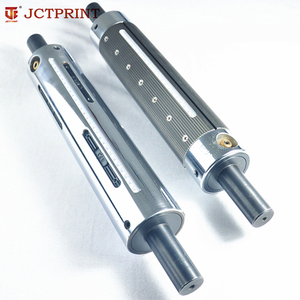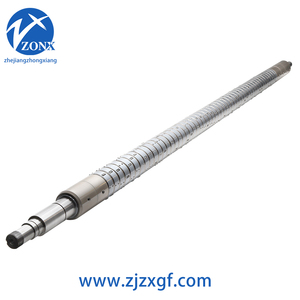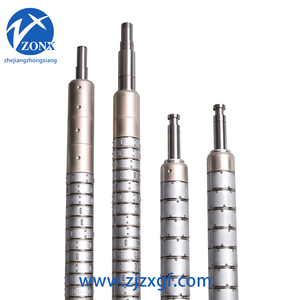
All categories
Featured selections
Trade Assurance
Buyer Central
Help Center
Get the app
Become a supplier

(1922 products available)


























Market Overview: The global market for mechanical expanding shafts is experiencing steady growth, driven by increasing automation in manufacturing processes. According to Research and Markets, the CNC spindle market, which is closely related, saw a rise from USD 2.41 billion in 2023 to USD 2.55 billion in 2024, with a projected CAGR of 6.21% reaching USD 3.68 billion by 2030. This growth reflects a broader trend toward high-precision machinery, where mechanical expanding shafts play a crucial role in enhancing operational efficiency. The rising demand for automated manufacturing solutions is a key driver, as industries seek to improve accuracy and reduce operational errors. Moreover, the integration of IoT technologies in machinery is expected to further boost the market, offering advanced monitoring and predictive maintenance capabilities.
Regional Insights: The demand for mechanical expanding shafts is particularly robust in regions like North America and Asia-Pacific. The U.S. market for CNC spindles highlights this trend, with substantial investments in modern manufacturing technologies. China, forecasted to grow at a 5.1% CAGR, is also a significant player, driven by its extensive manufacturing sector and government initiatives to enhance production capabilities. However, challenges such as high upfront costs and the need for skilled operators persist. As the market evolves, consumer behavior is shifting towards more sophisticated and reliable machinery, prompting manufacturers to innovate continuously. The emphasis on lightweight and durable materials, along with sustainability, is shaping new product developments, presenting opportunities for niche markets focused on high-performance mechanical expanding shafts.
An expanding shaft is simply a projection, usually cylindrical, that increases in diameter by applying pressure to a segment that subsequently expands it. Mechanical expanding shafts are devices that support, hold, and drive workpieces, especially in packaging, printing, engineering, woodworking, and textile industries. Different types are suitable for particular businesses.
Core Pneumatic Expanding Shaft
This variant utilizes air pressure to accomplish core expansion. It comprises flexible rubber segments mounted on a metallic shaft. Upon inflating the segments with compressed air, they increase in diameter, firmly gripping the workpiece. Core pneumatic expanding shafts are straightforward to operate and are frequently used in tasks involving quick material changes.
Manual Expanding Shaft
Mechanical manual expanding shafts typically have a hand crank or knob mechanism that increases the diameter of the workpiece. Manual expanding shafts are popular due to their affordability; nonetheless, they may require frequent operator input during use.
Automatic Expanding Shaft
Whether electric or electro-mechanical, the automated expanding shafts stand out from the rest due to their features. They usually have a motor-driven mechanism to expand and contract the workpieces automatically. Automation improves efficiency by allowing continuous semicircular workpieces and reducing operator inputs. It enhances safety and precision, and the production rates increase.
Optical Expanding Shaft
Optical expanding shafts are made to hold and evenly distribute workpieces with low weights, such as films, foils, and papers. They typically comprise lightweight but sturdy materials, maybe even plastics, and have a single-expansion mechanism to minimize distortion of the workpiece.
Mechanical Expanding Shafts with Safety Lock
Some mechanical expanding shafts have a safety lock, ensuring the workpiece remains locked and preventing accidental unlocking, thus improving safety. The safety lock is in the form of a pin or a screw that locks the expanding mechanism.
Roller-type Mechanical Expanding Shafts
Roller-type mechanical expanding shafts have the expansion mechanism in the form of rollers. The rollers are arranged in a way that they grip the workpiece evenly, and they have a low-profile design, which makes them ideal for use in situations where space is limited.
Usually, a mechanical expanding shaft is specified in terms of its application, as the general driving force behind the workings of a particular industry or machine. Nevertheless, a few key specifications apply that are common for all types and forms of expanding shafts.
Max Torque
The maximum amount of torque transmitted by an expanding shaft will affect how much load it can take. Torque is represented in Nm (Newton meters), and the higher the Nm, the more motor power it has behind it.
Max Diameter
The maximum diameter of an expanding shaft must fit the machinery component part, such as a drum or reel. For example, a coil expanding shaft diameter could be 6 inches.
Lengths
Length refers to the physical length between the two end faces of an expanding shaft. Lengths vary where different machinery applications need an expanding shaft to bridge a certain distance.
Material
Expanding mechanical shafts are made from different types of metal, plastic, and rubber materials, but primarily stainless steel and carbon steel are used, as both are strong supporting heavy weights and are resistant to rust and corrosion.
Operating Temperature
Temperature refers to what temperatures an expanding shaft can operate between 0 degrees and 70 degrees Celsius. This also includes environmental temperature, meaning whether it can work in high-temperature, high-humidity, and cold-resistant environments.
Pressure
Pressure is force acting perpendicular to the expanding shaft area, measured in Newtons. A high pressure/force on an expanding mechanical shaft from a machine could develop stress and strain that might break it.
The mechanical expanding shafts work in arduous machine industries. Therefore, it is necessary to examine each expanding shaft frequently and periodically. This includes looking for any scars, cracks, and corrosion in locker areas or any flaws in swivel coupling points.
A lubrication oil known to work with mechanical expanding shafts should be lubricated on the keys and keyways as friction occurs between them when a load is rotated, which applies pressure to the key and keyway. Oil trapped inside the key and keyway reduces friction during operation. Apply grease at the contact points of sliding bearings and lubrication points of the gear couplings.
Furthermore, always inspect gear couplings for signs of wear, such as tearing and cracking of the gear coupling. Check that there is no excessive backlash on the teeth, misalignment between coupling parts, and gaskets working between the spline and gear. Tighten any loose parts and reapply gear coupling lubrication as needed. Take care of the mechanical expanding shafts by examining them frequently, and they'll take care of the machines they drive.
Business purpose and application:
Expandable shafts are made for diverse industries. Take time to comprehend the specific industry and purpose they intend to serve. This will impact the type, materials, sizes, and designs of the mechanical expanding shafts chosen for the set business or application.
Quality and durability:
Worn-out mechanical expanding shafts can impact productivity, increase operating costs, and reduce product efficacy. Thus, their quality and durability must be prioritized. Choose those made from premium materials, like stainless steel, that can withstand harsh environments. Also, consider those with excellent load capacity and expansion range.
Ease of use and installation:
Universal mechanical expanding shafts usually have a hassle-free installation process, intuitive operation, and simple maintenance guidelines. A great choice will save time and operating costs.
Supplier
A reputable supplier will provide mechanical expanding shafts with the perfect combination of quality, price, and service. They often have good product knowledge and will provide expert advice to help business decisions. Their after-sales support will be vital if there's a problem with the product later on. Therefore, choose a reliable supplier with professional after-sales support and extensive product knowledge.
Q: What are the benefits of expanding shafts?
A: An expanding shaft has a long list of benefits. It offers simple installation and secure fastening of products without the use of through bolts. Expanding shafts also provide uniform load distribution for superior bearing and seal life. This type of shaft is easy to disassemble and reassemble, and it allows for product realignment.
Q: What are the common applications of an expanding shaft?
A: Mechanical expanding shafts are used in a wide range of industries, such as the packaging, printing, textile, and paper mill industries. In these industries, they are used to make heavy rolls and pulleys, hold gears, serve as keyless locks for shafts and bearings, and make split bearings and wheels, among others.
Q: What materials are suitable for mechanical expanding shafts?
A: Mechanical expanding shafts are mostly made from steel. The core or base is typically made from mild or alloy steel, while the expanding element is made from high-carbon steel. Other materials include stainless steel, aluminum, copper, brass, zinc, and chrome.
Q: How do expanding shafts work?
A: An expanding shaft works by increasing its diameter. This is achieved by expanding the tapered shaft using a mechanical, hydraulic, or friction drive.
Q: Are mechanical expanding shafts customizable?
A: Many manufacturers offer customizable mechanical expanding shafts. The most common customization options include size, length, color, print logo, and packing.